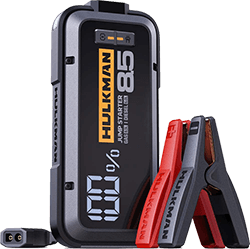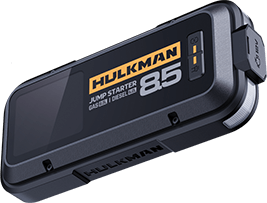Recent Articles
-
Understanding Lithium Battery Charging: Principles, Challenges, and How Hulkman Mega Engineers a Smarter System September 29, 2025
-
What Are Lithium Battery Cycle Counts and How to Extend Them? September 25, 2025
-
How to Properly Care for Lithium Battery Products September 24, 2025
Featured Products
note
Battery Types and Cold Weather Performance: Why Ternary Lithium Cells Make the Best Power Station Choice
Lithium batteries behave very differently in extreme temperatures, and choosing the right chemistry is crucial for winter or high-heat environments. Among common types like LFP, NCM, LMO, LCO, and lead-acid, NCM batteries deliver the best cold-weather performance, retaining up to 80% capacity at –20 °C, while LFP and lead-acid can lose nearly half their power. Cold charging is particularly dangerous—it slows ion movement and causes lithium plating, which leads to permanent battery damage.
In this article, we’ll cover
- Common Battery Types
- How Different Batteries Perform in Cold Temperatures
- High-Temperature Stability among Different Batteries
- Why Cold Charging is More Damaging than Cold Discharge
- Practical Guidelines for Protecting Lithium Batteries in Cold Environments
- Conclusion: Why the Hulkman Mega Power Station Uses NCM Cells
Common Battery Types
Modern rechargeable batteries can be grouped by their cathode materials. Today, lithium cobalt oxide (LCO), lithium iron phosphate (LFP), ternary lithium (NCM), lithium manganese oxide (LMO), lithium titanate (LTO), nickel–metal hydride (NiMH), and lead-acid batteries make up over 99% of the global market. Newer chemistries like lithium–sulfur, solid-state lithium, and sodium-ion are still in incubation.
For power tools and portable power station, the most common types are: LCO, LFP, NCM, LMO, and lead-acid batteries.
How Different Batteries Perform in Cold Temperatures
Cold weather reduces battery performance dramatically. Here’s how major chemistries compare at –20 °C:
-
Lead-acid: Capacity drops to ~50%. Thickened electrolytes slow ion conduction, and plate sulfation accelerates failure. (researchgate.net)
-
LFP (LiFePO₄): Retains ~50–60%. Its one-dimensional olivine channels can “freeze” in cold, and anode impedance rises sharply.
-
NCM (Ternary Lithium): Retains ~70–80%, showing the best cold resistance thanks to its 2D layered channels and low activation energy.
-
LMO (Lithium Manganese): Around 60%. Surface passivation raises resistance, but 3D spinel channels help ions move.
-
LCO (Lithium Cobalt Oxide): With a low-temperature electrolyte, it can reach ~70%, nearly matching NCM.
Ranking for cold-climate endurance:
NCM ≈ LCO (with special electrolyte) > LMO > LFP > Lead-acid
|
Metric |
NCM (Ternary) |
LFP |
Difference |
|
–20 °C capacity retention |
70–80% |
50–55% |
NCM ~20% higher |
|
–10 °C capacity retention |
75–85% |
60–70% |
NCM ~15% higher |
|
Ion diffusion coefficient @ –20 °C |
~10⁻¹¹ cm²/s |
~10⁻¹⁴ cm²/s |
NCM faster by 1000× |
|
Charge transfer impedance growth |
×3 |
×8–10 |
NCM polarizes less |
|
Cold-temperature charging |
0.3 C possible |
≤0.2 C, prone to lithium plating |
NCM safer window |
|
Structure |
2D layered |
1D channels |
NCM diffusion easier |
|
Electrolyte freezing point |
–40 °C |
–30 °C |
NCM more stable |
High-Temperature Stability among Different Batteries
Batteries fail differently in the heat:
-
Lead-acid: Grid corrosion begins at ~45 °C, doubles every +10 °C, and shells deform at >70 °C. No thermal runaway risk, but reliability declines fast.
-
NCM: Oxygen release at 180–200 °C; runaway at 210–250 °C (worse with higher Ni content).
-
LFP: More stable—oxygen release starts >500 °C, though 350–500 °C can trigger runaway if ignited externally.
-
LMO: Oxygen release at ~250 °C; runaway at 250–280 °C.
-
LCO: Oxygen release at ~180 °C; runaway at 200–220 °C.
In short, NCM balances cold efficiency with moderate thermal tolerance, while LFP offers the safest high-temperature window.
Why Cold Charging is More Damaging than Cold Discharge
When temperature drops, the viscosity of the electrolyte rises sharply.
- In storage mode, lithium ions are essentially immobile, so the effect is minor.
- In charging mode, however, a large number of lithium ions must be forced from the cathode through the electrolyte and intercalated into the graphite anode within a limited time window.
At low temperatures, this process becomes problematic:
- At −10 °C, the diffusion coefficient of lithium ions falls by two orders of magnitude compared to room temperature.
- At −20 °C, the ionic conductivity of the electrolyte is reduced to just one-fifth of its value at 25 °C.
The slowed ion transport induces polarization. Once the polarization becomes excessive, it can trigger lithium metal plating on the graphite surface (National Library of Medicine). This plating forms a metallic lithium film, and its evolution can follow 3 distinct paths:
Uniform current density → Dense lithium film
If current distribution is uniform, the plated lithium forms a compact, flat layer. This layer blocks active graphite sites, raises interfacial resistance several-fold, and makes subsequent charging increasingly difficult.
Non-uniform current density → Lithium dendrites
If the local electric field is uneven or defects exist, lithium ions preferentially deposit in high-field regions. This produces needle-like dendrites of metallic lithium (“active lithium”). Such dendrites can penetrate the surface film, causing internal micro-short circuits, leading to premature battery failure.
Dendrite breakage during discharge → Dead lithium
Once dendrites form, subsequent discharge can fracture them. The fresh fracture surfaces are immediately oxidized by the electrolyte. This reaction produces inactive “dead lithium”, which irreversibly reduces the battery’s usable capacity.
In short, charging at low temperatures accelerates structural and electrochemical degradation much more severely than discharging, making it one of the most critical challenges for lithium-ion batteries in cold climates.
Practical Guidelines for Protecting Lithium Batteries in Cold Environments
Cold climates put unique stress on lithium batteries. The electrolyte thickens, ion movement slows, and charging becomes riskier than discharging. Following a few precautions can significantly extend battery life in freezing conditions.
Pre-warm before charging. Never charge a frozen battery. Below 0 °C, sluggish ion movement makes lithium plating likely. Instead, allow the pack to gently warm by running at low power for 3–5 minutes, or bring it indoors before charging.
Maintain a safe storage level. For long storage, keep charge between 40–60%. If the level falls to about 20%, recharge promptly. Storing fully empty or full accelerates aging, and cold slows recovery from deep discharge.
Avoid fast charging in the cold. Quick charging below 10 °C sharply increases polarization and the risk of dendrite growth. Use slow charging (≤0.2C rate) to give ions time to diffuse safely into the anode.
Don’t rely on the sun. Sunlight may warm the outer case, but the cell core can remain at −10 °C. This uneven temperature encourages localized lithium deposits and shortens life. Controlled warming or built-in battery heaters are safer.
Use thermal management if available. Many advanced power stations and EV packs include pre-heating features. When possible, activate these before charging or heavy use.
Conclusion: Why the Hulkman Mega Power Station Uses NCM Cells

The Mega power station is built with NCM cells for one simple reason: they deliver superior cold-weather performance, high charging efficiency, and balanced safety.
Low-temperature storage and charging: Perfect for camping, expeditions, and winter emergencies.
High charge/discharge efficiency: More usable energy per cycle.
Proven in high-end applications: NCM cells also power flagship EVs like the Tesla Model 3 Performance, BMW iX3, and Hyundai Kona Electric.
In other words, the same chemistry trusted in premium electric vehicles is powering your Mega station—making it a power station that can run reliably in both freezing nights and hot summers.






















